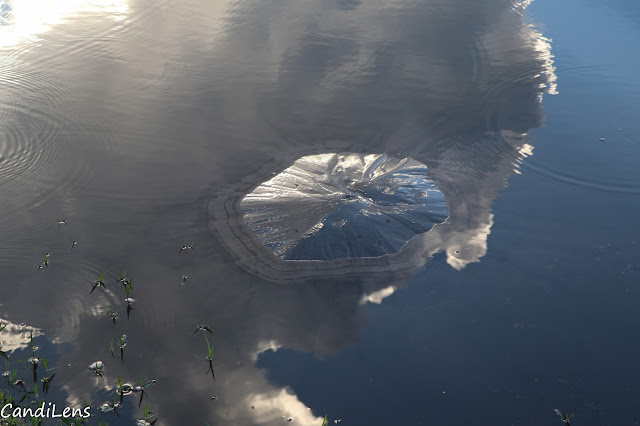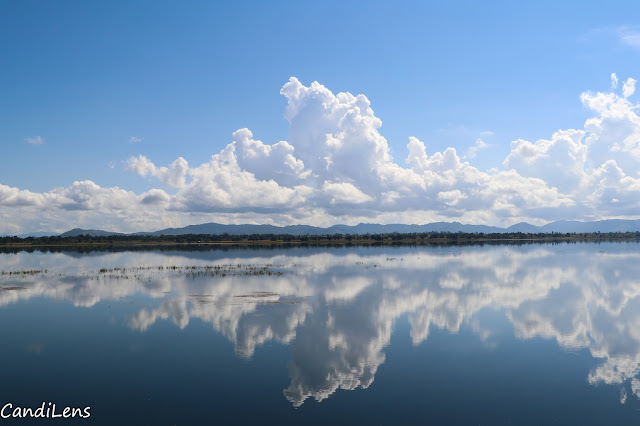The walk over the high grass
fields looking for the Kayan woman working her plot of land is still
fresh in my mind. It took place two days ago, at noon and it was very hot. The
dry grass was cutting my feet and spikes were all over my cotton dress. Many
thoughts running through my head: are there any snakes hiding in the
grass?...it is definitely too hot for this time of the year...the landscape
looks familiar, it reminds me of home..will the buffalo sense I am a
stranger?...are the bare feet of the little boy not hurting? In front of us a
little boy and his father were showing us the way. Finally we reached the paddy
field. We saw a very slim old Kayan old woman bent in two, concentrated on cutting
rice stalks with a sickle. The harvested crop was bundled all around her, on
the dry earth, to ease the transport. Looking around there were only empty
fields. The sun was blaring. She looked up at us in surprise.


This is just one of the many short stories I could write about my two-days trip
in the Kayah State. The time spent there was such an enrichment for both eye,
heart and mind. I remember the meeting with Rosalia, a Catholic woman, in the
Demawso market. I hold her wrinkled hand. I think about my grandmother. Rosalia
is 70 years old but she looks older with her wrinkled face and bent back. She
indeed tells us that she feels much older. All her children died, and she does
not get along well with her family-in-law. A cross hangs from her neck. She
believes in God, and one of the few who are visiting her is the priest.
 |
| Rosalia, an old woman we met in Demawso market |
I visited Loikaw and the surrounding
area during a two-day visit. I met different ethnic tribes, I learnt more about
the traditions and beliefs, and about the way of life of these people whose
main source of livelihood remains agriculture. I visited Kayah State to
admire the hills, lakes and the mountains which adorn the horizon, and to
breathe the fresh air. This is the smallest state in Myanmar in terms of area
and population, one hour flight from Yangon. Despite its small size, these
lands are home to a multitude of tribes with such a rich culture, and unique
traditions.
Kayah State opened its doors to
tourism in 2012. But only for some of the areas around Loikaw, the State's
capital. There are many places where access if prohibited mainly due to land
mines, and access to some villages (like Dawdemagyi (Kayah)
and Htekko (Kayaw)) is only allowed after receiving a permission from
the local authorities.
I knew the tribes speak their own
language and many old people do not speak or understand Myanmar. You sometimes
feel you are not in Myanmar. I was nevertheless surprised that my mingalabar and jezu be, the Myanmar hello
and thanks were usually not answered.
Many times a smile was all I got in return.
Once you arrive, and you travel
outside Loikaw to different villages to see the different tribes (Kayah, Kayan,
Kayin, Pa-O, etc), you will realise it is such a special place. I enjoyed very
much the quietude and the laid back atmosphere of the villages, the fresh air
in the mornings and the smell of flowers and grass during the day. I admired
the beautiful traditional costumes and their unique accessories. Nowadays less and less villagers dress traditionally every day, and the reasons are easy to guess (expensive fabrics and accessories, reduced fields of cotton, inexpensive market clothes, many layers of fabrics - too hot).
Lisu village
 |
| Most houses do not have windows - but as you notice in this picture they have a satellite dish |
Kayan women
Kayah woman
 |
| lacquered cotton leg ring |
I left Kayah State having the
feeling that I saw very little of this amazing country called Myanmar.
More information about the history, geography, culture, food, etc you can find here.
- what to see in
Loikaw, and in the surrounding area:
Demawso market takes place each
Wednesday and Saturday morning in the Demawso township.
Saturdays are busier
with more local ethnic groups dressed in their traditional costumes gathering
to sell and buy products (from food to clothes) in this medium sized market.
Amongst the curiosities you will see are dried frogs and small dried birds. You
can also taste the Kayah millet wine and rice wine made and sold by local
women.
 |
| Dried frogs |
 |
| Birds on sale which are bought to be cooked |
Taung Kwe Pagoda (or the
Broken Mountain) built on a hillock, has beautiful 360 degrees views over
Loikaw and the surrounding mountains. The pagoda is best visited during sunset.
The mist which starts to rise while the last rays of the sunshine disappear
behind the mountains is caused by the burning of garbage outside Loikaw's
houses.
 |
| Taung Kwe Pagoda - Loikaw view |
Naung Yah lake is
beautiful for an afternoon walk or you could have your dinner in one of the restaurants
there.
The State Cultural Museum is a good
place to learn more about the different ethnic races of Kakah State and their
way of life with an impressive display of bronze drums. The visit will not take
more than one hour. Unfortunately the English-language captions are not always
available. The museum clearly needs to be modernized in the near future.
You will sometimes notice along the road animist
poles that are erected by men when celebrating harvest festivals in April
and May. During these ceremonies villagers offer food and animals to the
spirits in return for protection. In the Kayah State the majority of the
population is either Buddhist or Christian but their animist beliefs and superstitions
are still deeply rooted and present in their religious practice.
The umbrella lake and the seven-tired lake are two natural sights
not to be missed, and they are a 20-minute drive outside the city. The umbrella
lake is a small muddy pond where volcanic activity shoots up sand which takes
the shape of an umbrella. It does not always produce the umbrella shaped forms
so you must be lucky to see them.
 |
| Umbrella Lake |
 |
| Seven-tired lake |
The guide will propose you a series of villages to see the Kayah
and Kayan women. Ask her/him to also take you to a Lisu village.
- good to know when planning your trip:
Search for a flight
and avoid the long drive to Loikaw from Yangon (around 13 hours). There are two
companies which fly almost daily from Yangon to Loikaw: Air KBZ (with a
stopover in Naypyitaw) and MNA (direct flight). Check your flight options and
book your flight on flymya.com.
Be aware that delays might happen especially in the high season. If you have
only two days, I would recommend you to fly Air KBZ (current arrival at 8:10)
and book the return with MNA.
If, at the same time, you want to visit Inle lake, you can fly
to Heho and from there rent a boat to cross Inle lake to Phekon. It takes
around four hours and a half. From Phekon jetty it is just 45 minutes by car to
Loikaw. This option is of course more tiring and time consuming. However the
landscape must be picturesque.
Book a hotel. We stayed at LoikawLodge By The Lake, and I would recommend you this cosy and new family-owned
hotel. The owners, German and Myanmar, speak excellent English, and they
will be very responsive to your emails and inquiries. You will feel like home. Additionally,
they have their own fully-licensed in-house travel agency, Ancient Geographic
Travels & Tours. Therefore they can help you with your itinerary, in
organising a car with a guide or apply on your behalf for the permission to
visit some of the villages. There are other hotel options in Loikaw as well.
What I believe distinguishes this place and makes it hard to beat are the efforts
they make to cook high quality food, and the easiness with which they
understand your wishes and try to make your stay unforgettable.
Hire a guide. You may
either ask the hotel to organise everything for you, for an additional fee, or
you can search yourself for a local guide. As you can imagine, the official
guides are few in the area. Here are two local certified guides: Mary 09 788 014 338 or Phoo Kae 09 792 570 063.
Eat local.
Do not forget to taste their famous pork sausages seasoned with the beautifully
flavoured Sechuan pepper. Additionally I am sure you will enjoy a Shan noodles
soup or salad in one of the tea shops in the city.
 |
| Traditional pork sausage bought by our guide for us to taste |
There are plenty of sights to
fill up a two days stay. If you have the possibility, take one or two days
extra to visit more ethnic groups (do not forget to apply in advance for the
permission) and maybe do a longer trek. Take a look below at the beautiful landscape (!without enhancing the colours in the photographs!) of Kayah State.
 |
| Landscape around Loikaw |















































